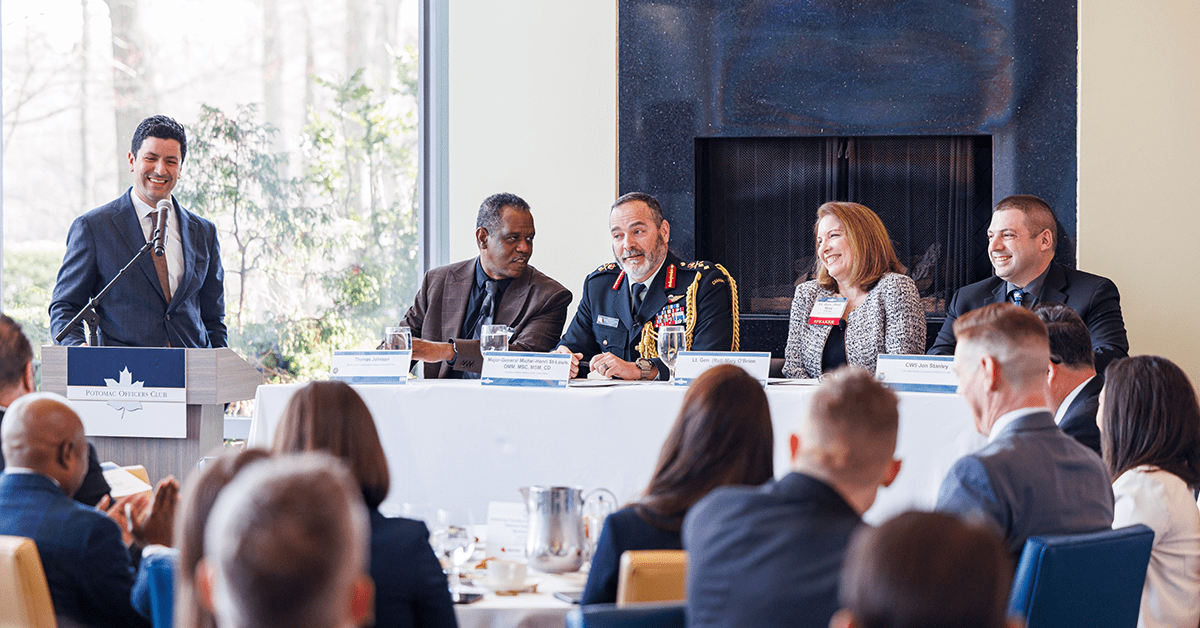Combined Joint All-Domain Command and Control, or CJADC2, is the U.S. Department of Defense’s ambitious plan to increase connectivity across all battle scenarios, remote outposts and amongst all DOD components and international allies. Over the last five years, the DOD has worked — and struggled — to achieve its goals for the initiative, and officials say there’s still much to be done.
“We have trouble talking to each other. We’ve been having that trouble since [the U.S. invasion of] Grenada and we haven’t fixed it yet,” stated CW5 Jon Stanley, chief technology officer of U.S. Indo-Pacific Command. CW5 Stanley participated in a panel discussion on CJADC2 at the Potomac Officers Club’s Achieving Transformative Cooperation for National Defense Forum on Thursday.
POC’s intimate breakfast forums are renowned spaces for GovCon networking and learning and just a tasteful, professional way to wake up. Don’t miss the next one, the 2024 5G Forum, on May 22. Register here now!
Fellow panel participant Major-General Michel-Henri St-Louis, a Canadian defense attache to the U.S., concurred with CW5 Stanley that the connectivity has not been achieved, and said the U.S. needs to remember to include its external allies.
Retired Lt. Gen. Mary O’Brien recited a list of priorities and tasks that must be completed for CJADC2 to be functional. (Lt. Gen. O’Brien is the former director of command, control, communications, computers and cyber and chief information officer, J6, for the Joint Staff at the Pentagon.) The priorities areas are:
- Establish, organize and operate a joint force headquarters
- Command subordinate forces
- Prepare, modify and publish plans, orders and guidance
- Quickly establish the command authorities, assign tasks and designate the operating area
- Prioritize and allocate resources
“Everyone’s going to want more of everything—more bandwidth, more weapons, more gas, more water, more food. How are you going to prioritize those resources? And which of those resources will be interdependent?”
- Manage the risk
- Coordinate, synchronize and integrate joint operations
- Ensure the flow of information across the staff in the joint force
- Coordinate control of joint capabilities to create lethal effects
“And more and more non-lethal effects”
“Everything that the general just mentioned needs to be done by a headquarters from platoon level to combined joint task force. I am not sure we are there. I actually know we are not there,” commented Major-General St-Louis.


However, despite the long road ahead, smaller goals are being set and accomplished within the CJADC2 timeline. Thomas Johnson, senior principal engineer for combined and joint C2 for the Marine Corps Tactical Systems Support Activity, discussed a cooperative research and development agreement, or CRADA, with Ultra Intelligence and Communications that has allowed for a free-flowing exchange of ideas about how to best establish CJADC2 systems.
“We just finished a successful agreement there—a successful task with a combined joint assessment…Through that CRADA, now it’s cooperative. Everybody [are] peers on the playing field,” said Johnson.
“Through that collaboration, let’s hear those ideas. Here’s how I think about this thing as the government, and this is how Ultra’s thinking about this as the technologist,” he continued.
Johnson also went on to cite a recent successful meeting the Army, Navy and Marine Corps held with nine partner nations, where data from the Ultra collaboration proved integral. He said that all involved parties — DOD, industry and allies — are all key players in completing CJADC2-related missions.







